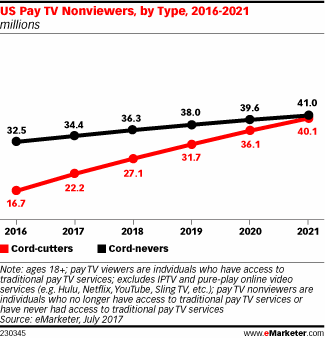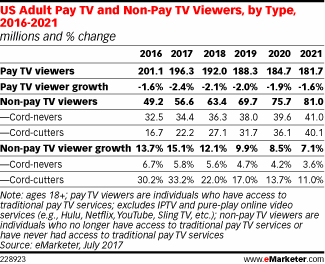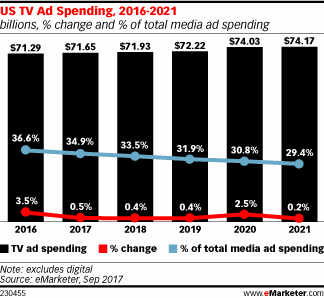Bad news for traditional pay TV: cord cutting is accelerating at a pace faster than previously estimated. According to a new industry report from eMarketer, there will be 22.2 million cord cutters ages 18 and older this year – a figure that’s up 33.2 percent over 2016. The firm said it’s had to revise its forecast as the pace of cord cutting has increased. Previously, it believed there would only be 15.4 million cord cutters in the U.S.
In addition, the so-called “cord-nevers” – meaning those consumers who never choose to subscribe to traditional cable or satellite TV in the first place – is growing, too. While the pace of that growth is slower – a more modest 5.8 percent this year – the total number of cord-nevers is higher. eMarketer says there will be 34.4 million U.S. adult cord-nevers in 2017.
When you combine the cord cutters and cord-nevers, there will be 56.6 million U.S. non-pay TV viewers this year.
 By 2021, eMarketer says the number of cord cutters will nearly equal the number of cord-nevers with 40.1 million for the former, and 41 million for the latter.
By 2021, eMarketer says the number of cord cutters will nearly equal the number of cord-nevers with 40.1 million for the former, and 41 million for the latter.
The firm attributes its revised forecast, in part, to the growing list of live streaming and over-the-top platforms that are now available.
In addition to existing players like Sling TV and PlayStation Vue, in under a year’s time we’ve seen new entrants in the live TV streaming space like AT&T’s DirecTV Now, which arrived late last year; YouTube TV, which launched in April; and Hulu Live TV, which arrived in May. There’s also a growing number of sports streaming services, including fuboTV and Stadium. Meanwhile, major companies have announced similar plans to enter the live streaming space, including CBS Sports and ESPN.
And that’s just live streaming TV.
The on-demand market, which includes Netflix, Amazon, Hulu, HBO, and others, is growing, too. Even Disney is prepping its own Netflix competitor.
 “Younger audiences continue to switch to either exclusively watching [over-the-top] video or watching them in combination with free TV options,: noted Chris Bendtsen, eMarketer’s senior forecasting analyst.
“Younger audiences continue to switch to either exclusively watching [over-the-top] video or watching them in combination with free TV options,: noted Chris Bendtsen, eMarketer’s senior forecasting analyst.
“Last year, even the Olympics and presidential elections could not prevent younger audiences from abandoning pay TV,” Bendtsen added.
Another factor accounting for the decline in pay TV viewership has to do with the way we’re now watching video content. U.S. adults simply aren’t watching TV as much as they used to, says eMarketer. The average time spent watching TV, excluding digital, will drop 3.1 percent to 3 hours, 58 minutes – that’s the first time it’s fallen below 4 hours per day, eMarketer notes.

Digital video viewing, meanwhile, has jumped up 9.3 percent over 2016 to reach 1 hour, 17 minutes.
Because of this shift in viewership, the pay TV ad market is now starting to feel the pain of cord cutting, too, the report said. U.S. TV ad spending this year will grow just 0.5 percent to $71.65 billion, a figure that’s down from eMarketer’s prior forecast earlier this year of $72.72 billion.
As a result, TV’s share of the total media ad spending budget in the U.S. will drop to 34.9 percent this year, and is expected to be under 30 percent by 2021.
Of course, the TV ad market isn’t the only one suffering due to cord cutting. Pay TV providers, including Dish, Comcast, Charter, and AT&T, are also feeling the effects on their stock prices as they hemorrhage pay TV subscribers.
Still, despite the quickening pace of cord cutting, pay TV continues to have a wide audience.
This year, over 196.3 million U.S. adults will watch pay TV (meaning cable, satellite or telco) – a figure that’s down 2.4 percent over 2016. But by 2021, that figure will have dropped nearly 10 percent, compared to five years earlier, to reach 181.7 million.
The only growth in the pay TV market is expected to come from those ages 55 and older. eMarketer says this is the only demographic that will see rising numbers, while all other age groups decline.
